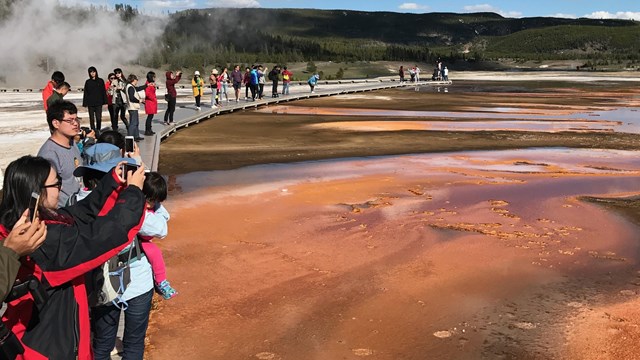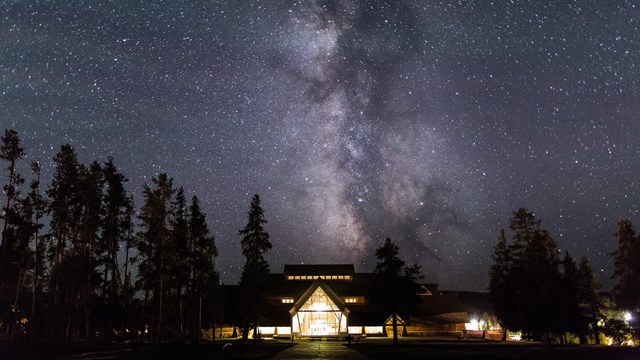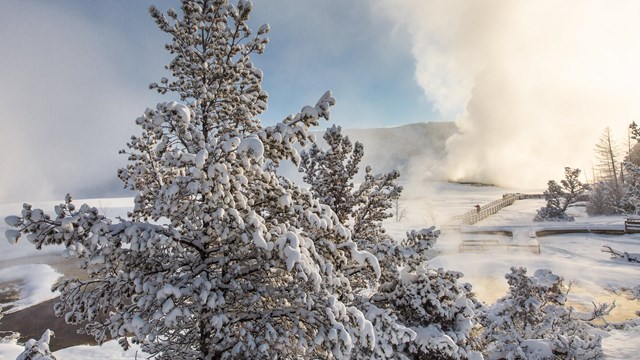Yellowstone has something to offer every month of the year. Summer is our busiest season with more than half our annual visitation occurs during June, July, and August. Spring and fall offer less crowds, but also cooler weather and fewer services.
A winter visit will fill your days with snowy landscapes, steaming geyser basins, and fewer people. However, access to the interior of the park (e.g. Old Faithful, Canyon) is restricted to oversnow travel and many facilities are closed, so it's important to plan a winter trip well in advance.
Be sure to read the current conditions before you head our way since some roads and facilities maybe be closed or affected by weather any month of the year.
Here’s a rundown of monthly highlights in Yellowstone (and where best to see them):
January and February
Visitation: Low
Services: Limited
Roads: Winter travel restrictions for all areas except Mammoth to northeast entrance
Suggested Activities: Skiing, snowshoeing, snowmobiling, snowcoach tours, overnight at Old Faithful, ranger-led programs, and wildlife watching
Highlights: American dippers (rivers with open water), coyotes and foxes hunting (snow-covered meadows throughout the park), rime ice and steam inversions (thermal areas), trumpeter swans (rivers with open water), and wolves (Lamar Valley)
March
Visitation: Low
Services: Limited
Access: Winter travel restrictions for all areas except Mammoth to northeast entrance.
Suggested Activities: Skiing, snowshoeing, snowmobiling, snowcoach tours, and wildlife watching
Highlights: Grizzly bears emerge from dens, neotropical migrants begin to arrive (bluebirds, meadowlarks, osprey, robins), and wolves (Lamar Valley)
Significant Dates: Yellowstone’s birthday (March 1). Interior roads close for spring plowing (Various dates).
April
Visitation: Low to moderate
Services: Limited
Access: Roads begin opening to regular vehicles (starting the third Friday of the month)
Suggested Activities: Hiking (lower elevations), skiing and snowshoeing (higher elevations), and wildlife watching
Highlights: Bison calving (Lamar Valley), black bears emerge from dens (Lamar Valley), bull elk antlers in velvet (Northern Range), chorus frogs (wetlands throughout the park), grizzly bears (roadside meadows), marmots (Northern Range), more birds arrive (ruby-crowned kinglets, Wilson’s snipe), Uinta ground squirrels, and wildflowers (buttercups, shooting stars, pasqueflower)
May
Visitation: Moderate (Memorial Day can be very busy)
Services: Limited
Access: All roads open by Memorial Day weekend
Suggested Activities: Hiking and backpacking (lower elevations), guided trips, and wildlife watching
Highlights: Black bears (Lamar Valley), bison calving (Lamar Valley), campgrounds begin to open, chorus frogs (wetlands throughout the park), elk calving (Mammoth Hot Springs), grizzly bears (roadside meadows), moose calving (Lamar Valley), pronghorn calving (Lamar Valley), ruffed grouse drumming (conifer forests), wildflowers (glacier lilies, bitterroot), and wolf pups emerge from dens (Lamar Valley)
Significant Dates: All roads open, fishing season opens, and some bear-management closures lifted (Memorial Day Weekend)
June
Visitation: Moderate to high
Services: Limited to full
Access: All roads open
Suggested Activities: Boating, camping, fishing (lakes), hiking and backpacking (lower elevations), ranger-led programs, and wildlife watching
Highlights: Bears less visible as they move to higher elevations, bighorn sheep calving (Lamar Valley, Calcite Springs Overlook), cutthroat trout spawning, elk calving (Mammoth Hot Springs), mountain goats calving (northeast entrance), wildflowers (arrowleaf balsamroot), songbirds in full song, waterfalls flowing at full volume, and high water limits access to backcountry campsites and popular swimming areas
Significant Dates: Boating services open on Yellowstone Lake, most campgrounds open (On or before June 15)
July
Visitation: High
Services: Full
Access: All roads open
Suggested Activities: Boating, camping, fishing (lakes, rivers, and streams), guided trips, hiking, backpacking, horseback riding, ranger-led programs, and wildlife watching
Highlights: Bison rut (Lamar & Hayden valleys), mosquitos, wildflowers (at higher elevations), and river levels drop (opening up many backcountry campsites)
August
Visitation: High
Services: Full
Access: All roads open
Suggested Activities: Hiking, backpacking, boating, camping, fishing, guided trips, horseback riding, ranger-led programs, and wildlife watching
Highlights: Wildfire smoke can obscure views and bison rut (Lamar & Hayden valleys)
Significant Dates: National Park Service birthday (August 25)
September
Visitation: High to moderate
Services: Full to limited
Access: All roads open (weather may cause temporary closures)
Suggested Activities: Camping, hiking, backpacking, fishing, guided trips, ranger-led programs, and wildlife watching
Highlights: Campgrounds begin to close for season, elk rut (Mammoth Hot Springs, Grant Village), black and grizzly bears (roadside meadows), raptor migration (Hayden Valley), fall color (above 7,000 feet), and fewer mosquitos
Significant Dates: Boating services close for season on Yellowstone Lake (Mid-September)
October
Visitation: Moderate to low
Services: Limited
Access: Roads begin closing for winter season (and weather causes many temporary closures)
Suggested Activities: Hiking, backpacking, fishing, ranger-led programs, and wildlife watching
Highlights: Bears return to lower elevations and are more visible along roads, elk rut (Mammoth Hot Springs, Grant Village), raptor migration (Hayden Valley), fall color (below 7,000 feet), and snow begins to accumulate (above 7,000 feet)
Significant Dates: Dunraven Pass and Beartooth Highway (outside northeast entrance) close (Mid-October)
November
Visitation: Low
Services: Limited
Access: Winter travel restrictions for all areas except Mammoth to northeast entrance
Suggested Activities: Hiking and wildlife watching
Highlights: Bighorn sheep rut (north entrance), bison begin migrating to lower elevations, snow begins to accumulate (below 7,000 feet), wolves (Lamar Valley)
Significant Dates: Interior roads close to vehicles and fishing season ends (Early November)
December
Visitation: Low
Services: Limited
Access: Winter travel restrictions for all areas except Mammoth to northeast entrance
Suggested Activities: Skiing, snowshoeing, snowmobiling, snowcoach tours, overnight at Old Faithful, and wildlife watching
Highlights: Bighorn sheep rut (north entrance), rime ice and steam inversions (thermal areas), trumpeter swans (rivers with open water), and wolves (Lamar Valley)
Significant Dates: Interior roads open to oversnow travel (Mid-December)



